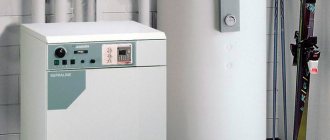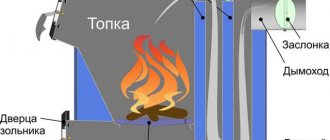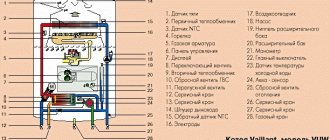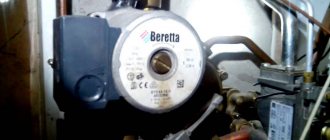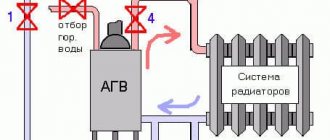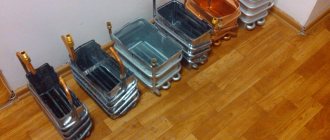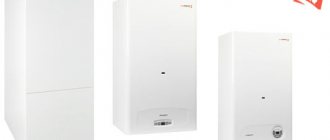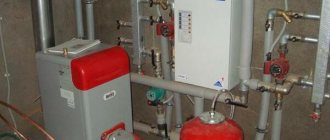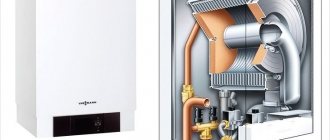Today, in terms of ease of maintenance and cost of energy, a household gas boiler is considered the best option for organizing a heating system for almost any private home. Typically, country property owners prefer floor-standing models for their versatility and reliability.
In addition, modern technology can do without auxiliary equipment for preparing hot water: thus, by purchasing a floor-standing double-circuit boiler, you will be able to “kill two birds with one stone” - at the same time heat your home (HW) and provide it with a full-fledged hot water supply (DHW).
What are double-circuit floor-standing gas boilers?
Modern gas floor-standing double-circuit boilers have an excellent design and operate almost silently, so they can be installed in any room that meets the requirements.
A gas double-circuit floor-standing boiler is a unit that combines the functionality of two devices at once - the boiler itself and the instantaneous water heater. In it, the coolant and hot water never mix with each other - they are immediately distributed over separate circuits.
The technical design of such boilers varies depending on the specific model, but the standard design is almost always the same:
- gas burner and ignition element;
- starting and main igniters;
- system for gas and smoke removal;
- combustion chamber and heat exchanger.
Optionally, a double-circuit floor-standing gas boiler has other components: an expansion tank, a blower fan, a circulation pump, an automatic control module, electronic sensors and safety valves to optimize operation, as well as monitor equipment safety.
It is advisable to install gas double-circuit floor-standing boilers in relatively small residential buildings (50–400 m2), where hot water supply does not require laying a long pipeline (7–8 m). Otherwise, heating running water will take too much time, which will result in excessive fuel consumption.
Also an important point is the number of people living in the house, because, as a rule, if there are two circuits, priority is given to water supply. In practice, this means that if you simultaneously use several hot water collection points, the volume of its production (even with excess power) will always be insufficient. Therefore, the total number of rooms with hot water consumption points (bathroom, kitchen, laundry) should not exceed three.
Principle of operation
A visual principle of operation of double-circuit boilers with priority for hot water supply (DHW).
To understand the general operating principle of double-circuit gas boilers, let’s consider how each circuit functions separately:
- heating - constantly “drives” the heated coolant through itself, which transfers heat through radiators to the surrounding space in the rooms;
- water heating - activated when a three-way valve is turned on, which redirects part of the coolant to heat tap water.
Thus, during periods of active use of running water, heating of the house is very limited (in the presence of a three-way valve) or completely turned off (when operating on the “DHW priority” principle). Thanks to this, the temperature of running water remains stable, regardless of the pressure, the number of open taps (within acceptable limits) and the pressure in the gas line.
When the hot water tap is closed, the three-way valve switches back to the heating circuit. If the coolant has already cooled down, the system again begins to generate thermal energy to resume heating, and if everything is fine with the temperature, it goes into standby mode (background heating).
The device is based on the example of the domestic two-circuit model Conord KSts-g-30N: minimum number of components, simple materials, simple non-volatile automation.
How to choose a room thermostat and save up to 30% per month on heating
Minimum required power
The choice of unit power primarily depends on the area of the house. Thus, the minimum power required for heating is calculated using the formula:
Q = S × 100 , where
Q – required power (kW), S – total heated area (m²), 100 – power norm per unit area with average heat loss of the house (W/m²).
For example, for heating a residential building with a heated area of 150 m², Q=150×100=15 kW.
However, given that we are talking about a double-circuit boiler, another 25–30% must be added to this value for hot water supply needs. To avoid operating the device at its maximum capacity, experts recommend making a reserve of another 10–20%, for a total of 150 m2 for a house, Q≈21–22 kW .
You should not choose units with a power that significantly exceeds the needs of the room. This will lead to increased fuel consumption and equipment wear. But, if the house has, for example, two bathrooms, then the number of hot water distribution points increases, which is also important to pay attention to when buying a boiler.
In non-standard cases, to determine more accurate power indicators, in addition to the square footage of the building, it is necessary to take into account the height of the ceilings, the degree of insulation of the building, the type of roof, the number of windows and external doors, the number of floors and the characteristics of the local climate. You can make the calculation using a special calculator (to get the result for the whole house, add up the indicators for each room and add 15-20% of the power reserve).
The required power of heating equipment is calculated separately for each room of the house. Enter the initial data or select the proposed options and click “Calculate”.
1. Set the value of the room area, m² 2. The number of external walls of the room is one and a half 3. External walls are directed to: north, north-east or east-south, south-west or west 4. The degree of thermal insulation of external walls is simple, not insulated, masonry walls 2 brick or light insulationhigh-quality design thermal insulation 5. Temperature level in the region in the coldest week of the heating season -35°C or less -25°C to -34°C -20°C to -24°C -15°C to -19° From -10°С to -14°С Not colder than -10°С 6. Ceiling height in the design room up to 2.7 m2.8 - 3.0 m3.1 - 3.9 m4 m and more 7. What is located above the ceiling? cold, unheated room/attic insulated attic/attic heated living space 8. Type and number of double-glazed windows ordinary (including wooden) double windows windows with double glazing (2 air chambers) double glazing with argon filling or triple glazing (3 air chambers) 9. Ratio of glazing area to floor area (Number of windows * window height * window width / floor area): less than 0.10.11-0.20.21-0.30.31-0.40.41-0 ,5 10. Select the planned method of connecting heating radiators 11. Planned location of the radiator and the presence of a screen practically not covered by a window sill, not covered by a screen covered by a window sill or wall projection covered by a decorative casing only from the outside completely covered by a screen Service. (not taken into account) TempK
Power calculation formula
Achieving accuracy in calculations is hardly possible for the average user, but you can try to get approximate figures. As a basis, it is necessary to take the specific power of the heating device, calculated for a specific region, multiply by the area of the heated room and divide by 10.
The specific power of the boiler is calculated for each region separately. To find out the indicator for a particular room, you need to use the formula (+)
The result obtained is the required boiler power under ideal conditions.
Depending on the characteristics of the room, adjustments must be made:
- for rooms with a height of more than 2.8 m, for every 10 cm of the above number it is necessary to increase the original value by 3%;
- two walls facing the street mean that it is necessary to increase power by 15%;
- an unheated room above requires an increase in the indicator by 12%, below - by 7%;
- if glazing occupies more than 8% of the total area of the room, then for each excess of 1% add 1% power;
- an external door that opens systematically increases heat loss by 15%.
When purchasing a double-circuit floor-standing gas boiler, whether a floor-standing or suspended model, you need to add another 20%. After all the calculations, it is also recommended to add a small power reserve - this way the load on the device will be less and it will last longer.
Reviews of floor-standing gas boilers with a DHW circuit: advantages and disadvantages
The pros and cons of floor-mounted double-circuit gas boilers can be assessed in advance if you listen to the opinions and reviews of more experienced owners.
| Advantages | Flaws |
| favorable price - a double-circuit device is noticeably cheaper than a conventional boiler and water heater separately | dependence of the nodes - if one of the circuits malfunctions, both water heating and home heating are immediately turned off |
| compactness - the size of such a boiler is almost no different from its single-circuit counterpart, which saves space | maintenance cost - as a rule, installation, repair and adjustment of units with two circuits are more expensive than standard ones |
| clear connection - supplying gas to just one point simplifies documentation, installation and repair of the system | separate placement - powerful floor-mounted boilers (more than 30 kW) can only be installed outside the residential area |
| service life - floor-standing models with two circuits last much longer than suspended (wall-mounted) equipment | the need for permission - installation and replacement of gas equipment must be approved by city authorities |
Some owners also note that during severe frosts their boilers stop working: formally there is a flame, but it is clearly not enough for heating. This occurs when the pressure in the line decreases and is not a minus - you just need to choose the right model that suits your climatic conditions.
Single-circuit
Gas-fired heating boilers are divided according to functionality. Depending on the method of heating the coolant, equipment is of two types: single-circuit and double-circuit.
Designs with one circuit are capable of heating the coolant, which will only be used in the heating system of the house. Therefore, such equipment is best used in small private homes.
The main advantage of a single-circuit boiler is that it costs an order of magnitude cheaper than its double-circuit counterparts.
How to choose a gas double-circuit floor-standing boiler?
The first thing you need to find out is whether the double-circuit gas boiler is suitable for the existing water supply conditions. Even short-term interruptions in the supply of cold water have an extremely negative impact on the performance of the entire system and can also lead to serious equipment breakdowns.
Also, the functionality and quality of the device is determined by its engineering design, so some characteristics need to be considered in detail.
Convection or condensation operating principle
The operating principle of conventional convection (efficiency 88-94%) and condensing (efficiency 104-116%) gas boilers.
The efficiency of a double-circuit gas boiler largely depends on the method of application of the thermal energy released during gas combustion:
- convection - uses for heating only the energy obtained from direct combustion of gas, while most of the heat leaves the combustion chamber along with the smoke;
- condensing - uses for heating both the energy obtained from gas combustion and the energy of water vapor contained in the combustion waste products.
Obviously, the second method is more economically profitable - it allows you to increase the efficiency of equipment by 15–20%. Additional heat is “recovered” by deeply cooling the smoke and condensing the steam in a low-temperature auxiliary heat exchanger (water economizer).
The disadvantage of condensing devices is their high cost - 1.5–2 times more expensive than conventional ones, but they pay for themselves within 3–5 years of operation.
In addition, it must be taken into account that the condensate formed daily* will have to be disposed of. Due to the presence of acid, this liquid cannot be drained into a local waste system (septic tank), so a method for neutralizing it should be provided in advance. However, if you plan to purchase a boiler with a power of about 30–35 kW or less, then provided that the room with the boiler has direct access to a centralized sewerage system, this restriction is not relevant.
* on average, domestic boilers of 15–24 kW produce 20–35 liters of condensate per day.
The functionality of such a boiler can later be expanded by connecting, for example, heated floors. But doing this during convection is strictly prohibited.
Structural design and material of the heat exchanger
A double-circuit boiler differs from a single-circuit analogue in the design of the heat exchanger - it can have both a combined and a separate device:
- bithermic – combines the DHW and OB circuits in a common housing according to the “pipe-in-pipe” scheme, with hot water for distribution located in the inner pipe, and the coolant for heating the room in the gap between the walls of the pipes;
Bithermic (double) heat exchanger. - monothermal - consists of two parts (they are located separately from each other, but are considered one part), in the first (primary) the coolant for radiators is heated, and in the second (plate) - water for personal use.
Differences between boilers with one bithermal heat exchanger and two separate monothermal ones.
Since heating is a closed system and the coolant circulates in a circle, there will be little scale. When heating running water, the situation is the opposite - scale forms constantly and in large volumes (depending on the hardness of the water), so this part periodically requires cleaning or replacement (if there is no cleaning).
A monothermal heat exchanger is more reliable in terms of maintenance and maintainability; it is quite easy to wash, and if it becomes completely clogged or fails, it can be partially “updated”. In the case of a bithermic analogue, you will have to change the entire device, which will subsequently be much more expensive. Also, a unit with separate heat exchangers is more convenient in everyday use, since both circuits in it operate independently of each other, which allows you not to shut off the heating circuit when using hot water.
The bithermal heat exchanger cannot be cleaned mechanically and is quite difficult to rinse. When scale forms, it clogs faster.
In addition to the design of the heat exchanger, the service life and reliability of heating equipment is affected by the type of material from which it is made:
- cast iron - characterized by increased heat resistance and resistance to corrosion, which is why it can work for decades (30–50 years), but it is very heavy and does not tolerate sudden changes in temperature, pressure and mechanical shocks;
- steel - more ductile and lighter, not demanding in terms of operating conditions, not afraid of thermal changes and can be easily repaired, however, it is prone to burning out and rust, so in general it is short-lived (10-12 years);
- copper - combines the best qualities of cast iron and steel, including corrosion resistance, durability (15–20 years) and high thermal conductivity, and it is also impervious to acids, making it suitable for condensing boilers;
- silumin - used exclusively in difficult operating conditions of condensation devices, because it is this alloy of aluminum with silicon that resists the action of chemically aggressive substances better than other metals.
In any case, in terms of shape, cast heat exchangers are preferable, because welds disrupt the structure of the material and weaken its anti-corrosion properties.
Availability of a storage tank
Vaillant ecoCOMPACT with built-in storage tank 200 l.
Such models are more practical, but have rather large dimensions. The next thing to consider when choosing a floor-standing gas double-circuit boiler is the method of preparing water for hot water supply:
- flow-through - after opening the tap, the water instantly begins to heat up;
- storage – water is heated for a long time in a special tank.
If you use hot water intensively, it is recommended to choose a boiler with a storage tank, the capacity of which may vary depending on the model (or equip the system with it). A supply of 40–50 liters per person is appropriate in any situation; therefore, for a family of, for example, 4 people, a tank of at least 120–180 liters is needed.
Also, the advantage of models with a built-in boiler is that they equalize the pressure in the system and maintain the set water temperature.
Volatile or non-volatile
The non-volatile gas boiler operates in autonomous mode without connecting to a power source. Among the automatic devices, it contains only a mechanical thermostat, which sets the heating mode for the coolant, which means that they must be started manually each time (piezo ignition).
Such devices are used in systems with natural circulation of water, which in the case of double-circuit models are not always effective. In this regard, during installation, it is recommended to calculate in advance the method of two-pipe distribution of heating pipes; the ideal subtype is a collector type of junction.
In non-volatile boilers it is not possible to install a storage tank, so if necessary, a separate boiler is connected to them.
A energy-dependent gas boiler functions only when constantly connected to the network; it is ignited automatically (electric ignition). The main elements that consume electricity are the circulation pump and the control board (the lowest power consumption is for class A++ equipment).
Such devices react more accurately and quickly to changes in room temperature, independently regulate the gas supply, flame power and many other nuances. They can set a certain operating mode for a day or a week in advance. This leads to a reduction in fuel consumption by 20–30%.
For energy-dependent devices, breakdowns due to power surges are a common occurrence. Repairs are not cheap; replacing a couple of parts will cost 30–50% of the price of the boiler itself. Many manufacturers even require the installation of a voltage stabilizer to maintain the warranty.
Combustion chamber design and types of smoke removal
According to the method of oxygen supply to the firebox (it is required to maintain an active flame), all double-circuit gas boilers are divided into two categories:
- with an open combustion chamber (atmospheric boilers) - they take air directly from the room itself in which the equipment is installed;
- with a closed combustion chamber (turbocharged boilers) - they do not draw in heated air from the room, but take it from the street through a coaxial chimney, which reduces heat loss.
The type of combustion chamber determines exactly how the combustion products should be discharged: through a shaft to the roof of the house or directly through a wall.
Open combustion chamber and natural draft through the chimney
In boilers with an open combustion chamber and natural draft, flue gases are removed through a full-fledged vertical chimney that goes out onto the roof. This entire design has a simple structure - for this reason, it is not expensive and, theoretically, more reliable. But the installation itself of atmospheric boilers is complicated.
Installation of such boilers is permitted only separately from living rooms, subject to compliance with all rules for organizing the chimney and the boiler room:
- the diameter of the chimney pipe is at least 130–140 mm, and the length is 3–4 m;
- it is made of stainless acid-resistant steel or asbestos;
- minimum boiler room area 3.5–3.7 m2 with a ceiling height of 2.2–2.5 m;
- the room has at least one window of 0.6–0.7 m2 and good ventilation.
If at least one of the listed rules is not followed, it would be wiser to prefer a device with a closed combustion chamber, with a chimney outlet through the wall. Otherwise, at best, the equipment simply will not be able to work, and at worst, carbon monoxide will begin to accumulate in the room, which is life-threatening.
Closed combustion chamber and natural draft through a coaxial chimney
Parapet non-volatile gas boiler Lemax Patriot-16 assembled with a coaxial chimney.
Parapet gas boilers are neither floor-mounted nor wall-mounted. In addition to the method of placement, they are distinguished by the fact that they have holes in the body, thanks to which they can be used as a radiator and heat the room in which they are installed. They need a coaxial chimney, for which one pipe is inserted into another: smoke is discharged through the inside, and air from the street is sucked in through the intermediate gap.
Such equipment can be installed anywhere, the main thing is below the window sill line (for example, instead of a radiator) and in any premises: private house, household. building, commercial building and even an apartment in a high-rise building. The only limitation is that the horizontal section of the pipes should not exceed 2.8–3.0 m.
Closed combustion chamber and forced draft
In boilers with a closed combustion chamber there is an inflatable fan (turbine), which forcibly removes smoke from the firebox directly to the street and automatically sucks in new air from the street through the same coaxial pipe. The devices are easy to install, as they are not demanding on the arrangement and size of the boiler room.
The main advantage of a turbine unit is that there is no access to an open source of fire, which reduces the likelihood of carbon monoxide entering the house.
In general, gas boilers with a closed combustion chamber are installed in premises for any purpose, but some nuances must be taken into account:
- the turbine located in the boiler creates a little additional noise;
- the coaxial pipe is routed through, which affects the appearance of the wall;
- smoke exit at eye level does not allow you to be closer than 4–6 m from the chimney outside the house;
- a turbine unit consumes 40–50 W/h more than a standard chimney unit.
Forced draft devices are more expensive than conventional ones, but they do not require the construction of a full-fledged chimney, so installation is cheap.
Criteria for the competent selection of modern turbocharged gas boilers
It is clear that there are differences between different types of combustion chambers and smoke removal systems, but they are all designed for the safe and efficient operation of a double-circuit gas boiler. So the final choice of model depends more on the financial capabilities of the buyer and specific operating conditions.
Efficiency and gas consumption
The efficiency factor (COP) of a heating boiler is an indicator that directly affects the efficiency of its use of energy resources.
For standard gas units, the efficiency value is in the range of 90–98%, for condensing models 104–116%. From a physical point of view, this is impossible: this happens if not all of the released heat is taken into account, so in fact the efficiency of convection boilers is 86–94%, and condensing boilers are 96–98%.
According to GOST 5542-2014, 9.3 kW of energy can be obtained from 1 m3 of gas. Ideally, with 100% efficiency and average heat loss of 10 kW, for 1 hour of boiler operation, fuel consumption will be 0.93 m3. Accordingly, for example, for a household boiler of 16–20 kW, with a standard efficiency of 88–92%, the optimal gas flow is 1.4–2.2 m3/hour.
Minimum required power
The choice of unit power primarily depends on the area of the house. Thus, the minimum power required for heating is calculated using the formula:
Q = S × 100 , where
Q – required power (kW), S – total heated area (m²), 100 – power norm per unit area with average heat loss of the house (W/m²).
For example, for heating a residential building with a heated area of 150 m², Q=150×100=15 kW.
However, given that we are talking about a double-circuit boiler, another 25–30% must be added to this value for hot water supply needs. To avoid operating the device at its maximum capacity, experts recommend making a reserve of another 10–20%, for a total of 150 m2 for a house, Q≈21–22 kW .
You should not choose units with a power that significantly exceeds the needs of the room. This will lead to increased fuel consumption and equipment wear. But, if the house has, for example, two bathrooms, then the number of hot water distribution points increases, which is also important to pay attention to when buying a boiler.
In non-standard cases, to determine more accurate power indicators, in addition to the square footage of the building, it is necessary to take into account the height of the ceilings, the degree of insulation of the building, the type of roof, the number of windows and external doors, the number of floors and the characteristics of the local climate. You can make the calculation using a special calculator (to get the result for the whole house, add up the indicators for each room and add 15-20% of the power reserve).
Possibility of using antifreeze
If seasonal residence or long-term frequent departures are planned in a private house, then in order to avoid damage to the pipes, it is necessary to prevent freezing of the simple liquid in the system. This can be done either by draining all the coolant, or by adding antifreeze to it - a chemical substance that, even at very low negative temperatures, does not freeze, i.e. does not harden, but turns into a gel without increasing in size.
In most cases, it is not recommended to use antifreeze in double-circuit gas boilers: if the instructions state that only water should be the coolant in the heating system, it is better not to take risks, since problems associated with the use of any solutions are not covered by warranty cases.
Some manufacturers allow specific brands of antifreeze to be poured into their units. But what is suitable for a certain model may not be suitable for another, so this issue must be decided in advance. Occasionally, it is permitted to use equipment that contains a list of suitable equipment.
Poll: do you use antifreeze as a coolant?
Additional criteria
Having decided on the main parameters of a double-circuit gas boiler, you can pay closer attention to other important characteristics:
- electricity consumption (in volatile devices) - on average, such equipment consumes about 2.0–2.5 kW per day, in a month it reaches 60–75 kW;
- maximum possible water temperature - in the DHW circuit, water heating is allowed, as a rule, to + 55...+ 65 °C, and in the OB circuit - up to + 80...+ 90 °C;
- operating pressure of the heating circuit - most double-circuit floor-standing gas units operate normally in the range of 2–4 bar, the operating pressure primarily depends on the material and thickness of the heat exchanger;
- hot water supply performance - the volume of liquid that the device can heat to a given temperature in 1 minute is 2.5–30 liters;
- automation functionality - the implementation of protective functions is mandatory in any case, but in many models attention is also paid to ease of use.
The main automatic elements that make it possible to partially or completely relieve a person from personal participation in the boiler control process include the following modules: self-diagnosis, programmer (scheduler), auto-ignition, flame modulation (regulation) and an external GPS control system.
Efficiency and gas consumption
The efficiency factor (COP) of a heating boiler is an indicator that directly affects the efficiency of its use of energy resources.
For standard gas units, the efficiency value is in the range of 90–98%, for condensing models 104–116%. From a physical point of view, this is impossible: this happens if not all of the released heat is taken into account, so in fact the efficiency of convection boilers is 86–94%, and condensing boilers are 96–98%.
According to GOST 5542-2014, 9.3 kW of energy can be obtained from 1 m3 of gas. Ideally, with 100% efficiency and average heat loss of 10 kW, for 1 hour of boiler operation, fuel consumption will be 0.93 m3. Accordingly, for example, for a household boiler of 16–20 kW, with a standard efficiency of 88–92%, the optimal gas flow is 1.4–2.2 m3/hour.
The best known manufacturers and models: prices and characteristics
The country of manufacture that produces double-circuit gas heaters largely determines their functionality and quality: you should not purchase untested equipment from Chinese sellers; it is recommended to opt for equipment made in Europe, South Korea or even Russia.
Particular attention should be paid to whether the boiler is suitable for the local climate and gas supply conditions: for example, in Asia there are almost no interruptions in the gas supply or a drop in pressure, but in post-Soviet countries this happens often, and therefore their models are adapted to domestic realities .
Baxi SLIM 2.230 I
The most common Italian boiler unit, proven by long-term practice, with a capacity of 22.1 kW. Equipped with an open combustion chamber, circulation pump and built-in 65 l boiler. Made of high quality materials: primary heat exchanger - gray cast iron, burner - stainless steel. Maximum gas consumption is 2.59 m3/h.
Cost : 114,090 – 135,300 rubles.
Manufacturer : Baxi (Baxi), Italy.
Protherm Bear 20 KLZ
Another reliable model with a power of 17 kW has a wide temperature control range (five preset modes). It is distinguished by the presence of a durable cast iron heat exchanger and a large storage tank of 90 liters. When operating at full power, it consumes fuel economically – up to 2 m3/h.
Cost : 104,870 – 131,040 rubles.
Manufacturer : Protherm (Proterm), Slovakia.
Zhukovsky AKGV-17.4-Z ZHUK
Domestic non-volatile gas double-circuit floor-standing boiler with a capacity of 17.4 kW. Consumes up to 1.87 m3 of gas per hour. The design is equipped with a simple steel heat exchanger without the inclusion of a water heating boiler, so overall this unit is quite inexpensive.
Cost : 21,460 – 22,390 rubles.
Manufacturer : Zhukovsky (ZhMZ), Russia.
Lemax Premium-16 B
An excellent, virtually problem-free Russian-made boiler with a capacity of 16 kW. With its modest dimensions, it has a maximum heat exchange area, which allows you to consume a minimum of gas - 0.95 m3/h. The model is one of the most economical, even in comparison with analogues in higher price categories. It also features a heat exchanger made of enameled steel (2 mm), resistant to salts and mineral oils, which extends its service life to 12-14 years.
Cost : 23,550 – 27,450 rubles.
Manufacturer : Lemax (Lemax), Russia.
Fondital Bali BTFS E 32 V
A high-quality and durable Italian model with a power of 32 kW is one of the best gas floor-mounted double-circuit boilers for heating a private home. It is distinguished by the use of high-quality materials, a closed combustion chamber, the presence of a layer of thermal insulation and almost silent operation. Produces hot water through the “AquaPemium” system, which includes steel (secondary) and copper (primary) heat exchangers, a filter and a 60-liter boiler. Gas consumption – up to 3.64 m3/h.
The only disadvantages are high cost, heavy weight and the lack of competent service specialists in some regions of Russia.
Cost : 160,820 – 233,780 rubles.
Manufacturer : Fondital (Fondital), Italy.
Operating principle
Double-circuit floor-standing boilers from different manufacturers have a certain design, but they have one common solution - there are two circuits inside. The one responsible for heating operates in a closed circuit. The water moves in a circle there, bypassing the radiators in the premises of the house. The heated liquid, which moves in a closed circuit, does not enter the second circuit. A separate valve is used for this. When the water consumption tap is opened in the faucets in the bathroom or kitchen, the valve shuts off the coolant in the heating system, which ensures the supply of hot water to the water supply circuit. When the taps are closed, everything happens in reverse.
Almost all double-circuit floor-standing boilers have similar technical components, and models from different suppliers differ in some details. Looking at the assembly diagrams, you can see that the devices have three blocks, among them the following should be highlighted:
- automation;
- burner;
- heat exchanger
As for automation, it is responsible for controlling the installation.
Prices: summary table
Comparative rating of double-circuit floor-standing gas boilers:
| Model name | DHW circuit capacity, l/min. | power, kWt | Gas consumption, m3/h. | price, rub. |
| Baxi SLIM 2.230 I | 13,4 | 22,1 | ≤ 2,59 | 125 000 |
| Protherm Bear KLZ | 12,0 | 17,0 | ≤ 2,00 | 118 500 |
| ZhMZ AKGV-3 ZHUK | 5,4 | 17,4 | ≤ 1,87 | 22 000 |
| Lemax Premium-B | 6,0 | 16,0 | ≤ 0,95 | 25 000 |
| Fondital Bali BTFS EV | 24,5 | 32,0 | ≤ 3,64 | 180 500 |
Heating principle: flow or storage
The flow principle of heating can be carried out by two types of heat exchangers:
- separate;
- bithermic.
Both of them have advantages and disadvantages, so the choice can only depend on the buyer of the equipment and his preferences.
A boiler with a separate heat exchanger has a primary (intended for heating) and a secondary (used to heat water) heat exchanger. The secondary heat exchanger has a built-in circuit that serves to heat water, which is heated by taking heat from the heating circuit coolant.
This type of boiler cannot operate in heating and water heating modes at the same time: as soon as one system comes into operation, the operation of the second is suspended.
The disadvantage of flow-through double-circuit floor-standing boilers is the excessive consumption of cold water, which must drain before warm water begins to flow into the tap. In addition, when using water from two or more points at the same time, the pressure in the hot water system will be uneven, as will the temperature of the water in the taps (+)
In bithermal heat exchangers, the water is heated by a burner located in a tube that runs inside the main heat exchanger. In such equipment, water heats up much faster. Such boilers are more compact and cheaper.
A significant disadvantage of bithermic boilers is the temperature difference in the hot water supply. This leads to the fact that very hot water can flow immediately after opening the tap.
For those houses where consumption is not so high, the operation of double-circuit boilers is quite capable of providing the minimum needs for warm water. But if consumption is planned in large quantities, it is better to provide a more powerful option - a boiler with a boiler connection, in which a certain supply of hot water will accumulate (+)
Double-circuit floor-standing gas boilers with a built-in tank, unlike flow-through models, can provide water in full. The volume of tanks varies from 25 to 60 liters. To heat large volumes, devices with high power are used. You can increase productivity even further by using boilers combined in cascades.
Where to buy a gas double-circuit floor-standing boiler for a private home?
In Moscow and Moscow Region
- MirCli (mircli.ru/kotly-otopleniya/napolnye-gazovye-kotly/dvuhkonturnye-kotly) – Leningradsky Ave., 80, building G, tel. +7 (863) 303–35–06, +7 (800) 775–29–90.
- Otoplenie.ru (https://www.otoplenie.ru/kotly/gazovye-kotly/napolnye-kotly) – 2 Silikatny Ave., 36, building 2, tel. +7 (495) 668–07–81, +7 (800) 775–65–61.
In St. Petersburg
- PRO-Teplo (https://proteplo-spb.ru/products/gazovye-napolnye-0) – st. Chugunnaya 14K (entrance from Mendeleevskaya 5), tel. +7 (812) 241–12–06, +7 (800) 775–63–03.
- Waterfall (ru/catalog/898/f/prigotovlenie_goryachey_vodi-is-protochniy_regim) – Kosygina Ave., 24 (Ladozhskaya), Leninsky Ave., 131, tel. +7 (800) 250–56–16.
As a result, I would like to remind you once again that a gas boiler, regardless of the specific configuration, must meet all regulatory and legislative requirements and be certified for use in Russia - because only if these conditions are met is its complete safety guaranteed.
Gas boilersDouble-circuit BoilersFloor-standing
About the design and principle of operation from the point of view of the combustion chamber
The equipment described may have a combustion chamber of one of two types, which are open or closed. Quite often, consumers wonder how they differ. The operation of an open chamber involves the intake of air for fuel combustion from the same room where the device is installed. Oxidation products are removed through the chimney. Therefore, the unit should be installed only in a separate room that has an intensive ventilation system. If this feature is not taken into account, the device will not work well due to lack of fresh air. In this case, carbon monoxide will begin to penetrate into the home, which can create a danger not only to health. Moreover, it can even threaten human life.
It is important to remember that gas boilers with an open chamber can only be installed in a separate room. For the normal functioning of such units, a vertical chimney is required, which will provide natural draft. A double-circuit floor-standing boiler with a closed chamber operates on a different principle. For such devices, a coaxial chimney is constructed, into which combustion products penetrate using forced draft. This entire process is ensured by an electric fan. One pipe is placed into another, larger in diameter, which allows you to get the same coaxial chimney. Air enters through the outer pipe, which helps support the combustion process. But through the inner pipe, combustion products are discharged outside. Such a chimney can have any direction - both vertical and horizontal.
Design and principle of operation from the point of view of burners
Burners in boilers are responsible for power. In boilers they are mounted in chambers. Here fuel combustion occurs, which is accompanied by the release of heat. Oxidation products are removed to the outside using draft through the chimney. Above the burner there is a heat exchanger, which is a container with coolant. When combustion products reach the top, they rush into the chimney and heat the walls of the container, which helps to increase the temperature of the coolant. In this case, water enters the external circuit through special pipes.
A floor-standing double-circuit gas heating boiler can have one of two types of heat exchanger. The most common today are plate and bithermic structures. The former consist of copper tubes and plates, which are treated with an anti-corrosion compound during the production process. One pipe provides heating, while the other is responsible for hot water supply. Heat is transferred to the environment using plates.
Looking at the bithermic heat exchanger in more detail, you can understand that it has a different design. It provides for the presence of two tubes, which have different diameters and are placed one inside the other. The smaller one is used for hot water supply, while inside the larger diameter pipe there is water for heating. Such a device is not so reliable, and the water quality is not very high. This is due to the fact that over time, sediment forms on the walls of the tubes, clogging the interaxial space. This causes the device to stop working effectively.
Advantages and disadvantages
The advantages of dual-circuit systems include the following:
- Fuel efficiency. Since the competitor of a double-circuit boiler is usually the “single-circuit boiler + BCS” combination, the consumption of natural gas will be higher in the second case.
- Compact sizes. If we consider that the lion's share of double-circuit boilers are used in wall-mounted versions, it turns out that such systems can be located not only in the utility rooms of private houses, but also in ordinary kitchens of small apartments, where they can take up no more space than a kitchen cabinet.
- Ready solution. In the case of a double-circuit boiler, there is no need to purchase additional equipment and think about its compatibility. A heater, instantaneous water heater and circulation pump are already combined in one device. And all this is automated!
However, there are no ideal boilers; there are also disadvantages:
- Impossibility of simultaneous operation of two circuits. When hot water is turned on, the heating system is blocked by a valve. Therefore, high consumption of hot water can lead to a drop in room temperature.
- Wall-mounted boilers, especially compact ones with a small burner, cannot always heat water to the required temperature while maintaining strong pressure. The temperature at different water intake points may differ - the further the tap is from the boiler, the colder the water will be when opened at all points simultaneously.
- The secondary plate circuit is quite sensitive to the quality of running water. This requires either regular cleaning with chemicals or installing a special softener for hard water.
The issue of cost is deliberately considered separately, since it is both a minus and a plus. The cost of any double-circuit boiler will always be higher than that of a single-circuit boiler. But if you compare it with a boiler to which an indirect heating boiler is connected, then a double-circuit boiler will be cheaper.
